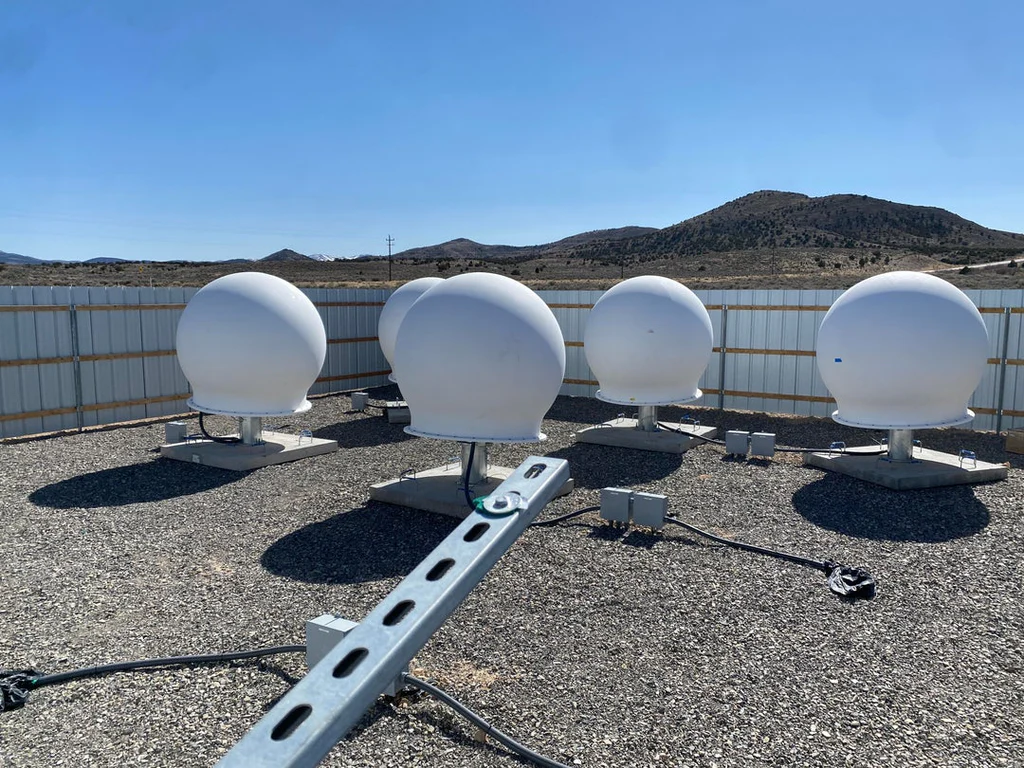
Starlink, the satellite internet constellation developed by SpaceX, has been making waves with its promise of high-speed internet access across the globe, especially in remote and underserved areas. While much of the attention has focused on the user terminals – the dishes that connect to the satellites – the ground stations, also known as gateways, play a crucial role in the network. These ground stations are pivotal in bridging the gap between the satellites in orbit and the terrestrial internet infrastructure.
In this article, we will delve into the details of Starlink ground stations, exploring their function, design, installation, and the technology that makes them the backbone of the Starlink satellite internet system.
What is a Starlink Ground Station?
A Starlink ground station, also referred to as a gateway, is a terrestrial relay station that communicates with the Starlink satellites orbiting the Earth. These stations are essential for the transmission of data between the satellites and the internet backbone on the ground. Essentially, they act as intermediaries, receiving data from the satellites and routing it to the appropriate internet networks, and vice versa.
Functions of a Ground Station
- Data Relay: Ground stations receive data from satellites and forward it to the internet backbone.
- Command and Control: They send commands to the satellites, ensuring proper operation and alignment.
- Network Management: They help manage the network traffic, ensuring smooth and efficient data flow.
Design and Technology of Ground Stations
Starlink ground stations are equipped with advanced technology to ensure efficient and reliable communication with the satellites. Here are some of the key components and technologies involved:
Antenna Arrays
Ground stations use large, phased-array antennas to communicate with multiple satellites simultaneously. These antennas can steer their beams electronically, allowing them to track the fast-moving satellites without physically moving the antenna.
Fiber Optic Connectivity
To handle the vast amounts of data transmitted, ground stations are connected to the internet backbone via high-speed fiber optic cables. This ensures low latency and high-speed data transfer between the satellites and the internet infrastructure.
Redundancy and Reliability
Ground stations are built with redundancy in mind. They have backup systems for power, communication, and data handling to ensure continuous operation even in case of equipment failure.
Installation of Starlink Ground Stations
Installing a Starlink ground station involves several steps and requires careful planning and execution. Here’s an overview of the process:
Site Selection
Choosing the right location for a ground station is crucial. The site needs to have clear skies for unobstructed satellite communication, and it should be near existing internet infrastructure for easy connectivity.
Construction and Setup
Once a site is selected, construction begins with building the necessary infrastructure, including antenna mounts, power supplies, and data centers. The antennas and other equipment are then installed and tested.
Testing and Calibration
After installation, the ground station undergoes rigorous testing and calibration to ensure it can communicate effectively with the satellites and handle the data traffic efficiently.
SpaceX’s Expansion Plans for Starlink Ground Stations
SpaceX, the aerospace manufacturer and space transportation company founded by Elon Musk, plans to build and operate 99 Starlink Gateway stations in 40 U.S. states and territories, including Guam and Puerto Rico. Some of these sites are under construction, while others have been operational since the company started providing internet services in 2019. Currently, SpaceX operates approximately 150 ground stations around the world, which play a crucial role in linking the Starlink satellites with internet data centers on the ground. These data centers connect to existing fiber-optic infrastructures and send data to the Starlink satellites in Low Earth Orbit.
Future Developments with Starlink V2 Satellites
With the launch of more Starlink V2 satellites, some satellites will not require direct connections to gateways because each V2 satellite features inter-satellite communication ‘laser links’. These links enable the satellites to ‘laser beam’ data to one another in orbit, which will enable even faster internet service.
E-band Capabilities for Enhanced Performance
In December 2022, SpaceX filed with the Federal Communications Commission (FCC) to build or upgrade around 21 U.S. gateway sites equipped with “E-band capabilities” for the Starlink V2 satellites. Some of these gateways are already operational, described as ‘live’ in the updated list of locations.
Highlight: Adelanto, California
Earlier this year, Adelanto Mayor Gabriel Reyes announced that SpaceX received permission to build a cutting-edge Starlink ground infrastructure in Adelanto, California, to support its second-generation Starlink satellites in orbit. These stations are expected to significantly enhance uplink and downlink speeds, promising a more seamless internet experience for users. The “Los Angeles Gateway Earth Station” facility is located west of Highway 395 and near El Mirage Road, and includes eight antennas, which are each 5-feet in diameter, according to the FCC filing.
Mayor Reyes highlighted the benefits of having the SpaceX facility in close proximity, stating, “Such proximity means that our residents will receive the quickest internet speeds from Starlink’s internet offering, once launched.” This facility marks another significant step in SpaceX’s mission to provide faster and more widespread internet access via a low-orbiting satellite network.
Locations of Starlink Gateway Sites
Besides Adelanto, the locations of other Starlink Gateway sites that SpaceX requested to build or already operates include:
- Adelanto, California (construction ongoing)
- Anchorage, Alaska (live)
- Anderson, South Carolina (construction pending)
- Angola, Indiana (construction ongoing)
- Arbuckle, California (construction pending)
- Arlington, Oregon (construction pending)
- Arvin, California (construction pending)
- Atlanta, Georgia (construction pending)
- Baxley, Georgia (live)
- Beekmantown, New York (live)
- Bellingham, Washington (live)
- Benkelman, Nebraska (construction ongoing)
- Blountsville, Alabama (construction ongoing)
- Boca Chica, Texas (live)
- Boydton, Virginia (construction pending)
- Brewster, Washington (live)
- Broadview, Illinois (live)
- Brunswick, Maine (construction ongoing)
- Butte, Montana (live)
- Cass County, North Dakota (live)
- Charleston, Oregon (live)
- Charleston, South Carolina (construction pending)
- Cheyenne, Wyoming (construction pending)
- Clinton, Illinois (construction ongoing)
- Colburn, Idaho (live)
- Columbus, Ohio (unknown)
- Conrad, Montana (live)
- Des Moines, Iowa (construction pending)
- Dumas, Texas (live)
- Elbert, Colorado (live)
- Elkton, Maryland (unknown)
- Evanston, Wyoming (live)
- Fairbanks, Alaska (live)
- Fort Lauderdale, Florida (live)
- Frederick, Maryland (live)
- Gaffney, South Carolina (live)
- Greenville, Pennsylvania (live)
- Hamshire, Texas (live)
- Hawthorne, California (live)
- Hillman, Michigan (live)
- Hillsboro, Texas (live)
- Hitterdal, Minnesota (live)
- Inman, Kansas (live)
- Kalama, Washington (live)
- Kenansville, Florida (live)
- Ketchikan, Alaska (live)
- Kuparuk, Alaska (live)
- Lawrence, Kansas (live)
- Litchfield, Connecticut (live)
- Lockport, New York (live)
- Loring, Maine (live)
- Lunenberg, Vermont (live)
- Mandale, North Carolina (live)
- Manistique, Michigan (live)
- Marcell, Minnesota (live)
- Marshall, Texas (construction ongoing)
- McGregor, Texas (live)
- Merrillan, Wisconsin (live)
- Molokai, Hawaii (live)
- Mt Ayr, Indiana (live)
- Murrieta, California (construction pending)
- Nemaha, Nebraska (live)
- New Braunfels, Texas (live)
- Nome, Alaska (live)
- Norcross, Georgia (live)
- North Bend, Washington (construction pending)
- Olympia, Washington (construction pending)
- Panaca, Nevada (live)
- Port Matilda, Pennsylvania (construction ongoing)
- Prosser, Washington (live)
- Punta Gorda, Florida (live)
- Quincy, Washington (construction pending)
- Redmond, Washington (live)
- Richardson, Texas (construction pending)
- Roberts, Wisconsin (construction ongoing)
- Robbins, California (live)
- Robertsdale, Alabama (live)
- Rolette, North Dakota (live)
- Roll, Arizona (live)
- Romulus, New York (construction ongoing)
- San Antonio, Texas (construction pending)
- Sanderson, Texas (live)
- Savanna, Oklahoma (construction ongoing)
- Savannah, Tennessee (unknown)
- Sheffield, Illinois (construction ongoing)
- Slope County, North Dakota (live)
- Springer, Oklahoma (live)
- Sullivan, Maine (live)
- The Dalles, Oregon (construction pending)
- Tionesta, California (live)
- Tracy City, Tennessee (live)
- Unalaska, Alaska (live, as reported by TESMANIAN today)
- Vernon, Utah (live)
- Warren, Missouri (live)
- Wichita Falls, Texas (construction pending)
- Wise, North Carolina (live)
- York, Pennsylvania (construction pending)
- Puerto Rico (unknown)
- Guam (unknown)
Current Facts and Figures About Starlink
- Number of Satellites: As of today, SpaceX operates approximately 4,764 satellites in Low Earth Orbit.
- Global Coverage: SpaceX aims to provide global coverage, including remote and underserved areas.
- Subscribers: Over 1.5 million subscribers worldwide use Starlink for high-speed internet services.
- Internet Speeds: Starlink promises internet speeds ranging from 50 Mbps to 150 Mbps, with latency as low as 20 ms in ideal conditions.
Custom Mounting Solutions by Starlink Installation Pros
Given the complexity and importance of ground stations, their installation often requires customized solutions. This is where Starlink Installation Pros come in. They specialize in providing tailored installation services, ensuring that each ground station is optimally set up for maximum performance.
Expertise and Experience
Starlink Installation Pros have extensive experience in installing ground stations, understanding the specific requirements and challenges involved. They use their expertise to provide solutions that meet the unique needs of each site.
Customized Mounting Solutions
From designing and building custom mounts for antennas to setting up data centers and power supplies, Starlink Installation Pros offer comprehensive solutions tailored to the specific needs of each ground station.
Ongoing Support and Maintenance
After installation, they provide ongoing support and maintenance to ensure the ground stations continue to operate smoothly and efficiently.
Conclusion
Starlink ground stations are a critical component of the satellite internet network, ensuring seamless and efficient communication between the satellites and the internet backbone. Their advanced technology, strategic placement, and reliable operation are key to the success of the Starlink project. With the expertise of Starlink Installation Pros, these ground stations are installed and maintained to the highest standards, ensuring they can meet the demands of the rapidly growing Starlink network.
FAQs
1. What is the role of a Starlink ground station?
A Starlink ground station acts as an intermediary between the satellites and the internet backbone, relaying data and managing network traffic.
2. How many Starlink ground stations are there?
As of today, there are approximately 150 ground stations globally, with plans to expand to 99 stations across 40 U.S. states and territories, including Guam and Puerto Rico.
3. What technology is used in Starlink ground stations?
Starlink ground stations use phased-array antennas, fiber optic connectivity, and redundant systems to ensure reliable and efficient operation.
4. Why is site selection important for ground stations?
Site selection is crucial to ensure clear satellite communication and proximity to existing internet infrastructure for efficient data transfer.
5. What services do Starlink Installation Pros offer for ground stations?
Starlink Installation Pros provide customized mounting solutions, construction, setup, testing, calibration, and ongoing maintenance and support for ground stations.


